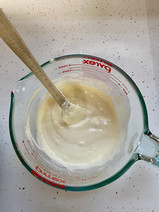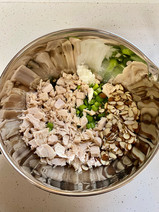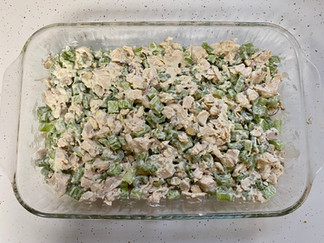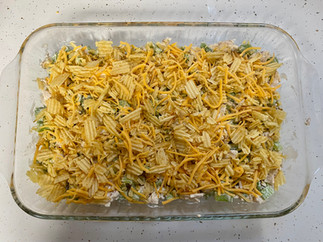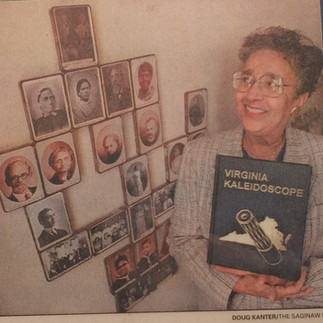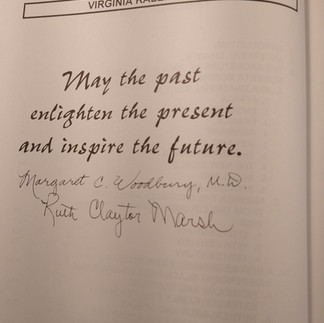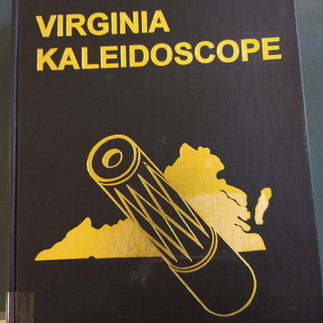According to her obituary, Ruth Marsh enjoyed luncheons at her church, Warren Avenue Presbyterian Church where she was member until it closed. So we begin with a Warren Ave Church cookbook recipe, and then take a closer look at the life of Ruth Marsh.

W.A.P.C. Hot Chicken Salad
By: Opal Amen
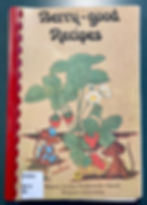
2 cup cubed chicken
2 cup celery
1 cup mayonnaise
½ cup almonds
2 Tbsp lemon juice
2 tsp grated onion
½ tsp salt
1 cup crushed potato chips
½ cup grated cheese (sharp Cheddar)
Combine ingredients except cheese and potato chips. Toss lightly. Pile lightly into baking dish. Sprinkle lightly with potato chips and cheese. Bake in very hot oven (450°) for 10 minutes.
Makes 5-6 servings.
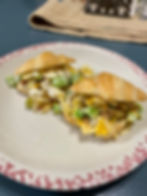
Ruth Marsh, wife of Saginaw’s first Black mayor, Henry Marsh, led an interesting life that touches on much of what Black Americans faced throughout the later half of the twentieth century. She shared her family’s stories in a genealogy she and her sister, Margaret, wrote and published in 1996, entitled Virginia Kaleidoscope.
Ruth came from a family of high achievers. When Margaret graduated from high school as valedictorian the Roanoke Tribune noted the family’s many honors, writing:
Miss [Margaret] Claytor was valedictorian of her class…her achievements ring true to Claytor tradition. She is the youngest of a family of four brothers and four sisters who are making outstanding contributions in their particular fields. There is Dr. F. W. Claytor and Dr. J. B. Claytor, Jr. both are prominent physicians of Roanoke. Mrs. Bernice Boddie, who is the wife of Dr. Lewis Boddie, a physician of Los Angeles, California [and a medical technician herself]; Mrs. Roberta Palmer, another sister with whom Margaret lives and who is a teacher of Mathematics in one of the high schools in Washington, D.C.; Mr. Ralph V. Claytor, who is Business Manager of the Clinic and proprietor of the only Esso Service Station operated by a member of our group in the City of Roanoke. Then there is Dr. W. S. Claytor, the Dentist; and Mrs. Ruth Marsh whose husband in [sic] a popular attorney in Detroit, Michigan. Then there is the Claytor Memorial Clinic which stands as a monument to the lovely mother of the Claytors, Mrs. J. B. Claytor, Sr. It was the late Mrs. Claytor’s dream of a Clinic conducted by her husband, the late Dr. J. B. Claytor, which prompted him, after her death, to build a clinic in her memory. Thus we find the Claytor Memorial Clinic, with father and three sons as practicing physicians and a dentist and one taking over as business manager.
So true to tradition, Miss Margaret Claytor, the youngest of the clan, is making strides,...( Roanoke Tribune, May 1954, republished in Virginia Kaleidoscope, 454).

Virginia Kaleidoscope is an entertaining page turner, and while we wish we could detail all the Claytor siblings' lives, we will have to (mostly) bow to brevity and contain ourselves to Ruth and influences on her foundational years.
Her father, John B. Claytor, was a physician. He also invested wisely in real estate and this afforded the family a more comfortable lifestyle than many. Even with a level of financial security, the family still faced discrimination and precarious moments due to racism. For example, although Dr. Claytor was held in esteem in the community (respected enough that both Black and white doctors worked to save his wife Roberta’s life following complications of childbirth), he was prohibited from joining the main professional organization of medical doctors, the American Medical Association, just because he was Black. He could only be affiliated with a Black hospital rather than a white one, which meant he could not be admitted to the AMA. He did join and actively support the National Medical Association, an organization founded by African Americans in Atlanta, GA in 1894.
When he bought a block of land to develop, which was near the white section of Roanoke but still within the boundaries of the Black section, he was harassed. The Ku Klux Klan burned a cross on the property. Then white contractors refused to build. When John brought outsiders in to serve as contractors, white people continued to try to make it difficult to transport building supplies, even going as far as reporting him to the ASPCA for cruelty to his horse (the charge was deemed unfounded; the horse was well cared for). John managed to build despite the harassment.
The Ku Klux Klan also burned a cross on their property after their home-building was completed. The KKK waited until the family moved in before making their violent display.
The family also enjoyed traveling although they had to take precautions like most Black people at the time. They could not expect to find friendly accommodations or restaurants if they did not plan ahead, so they traveled routes where they had friends or family who could take them in along the way. Once, in Georgia, a police officer pulled them over because Roberta was darker-skinned than her husband, and the officer thought it looked like a white man was driving with a Black woman. Even though John confirmed his race, the officer still made Roberta ride in the backseat.
Despite these injustices, the family prospered and seemed very supportive of one another. Ruth’s parents also encouraged all their children to stay active. That included chores on the family’s farm - a gift from John to Roberta so she could foster her love of growing things - and the service station, the only Black-owned station in the city.
During WWII, it was hard to hire men to work at the station, so Ruth operated the station from the time she got out of school until closing at 11 p.m. “This involved not only pumping gasoline and washing windshields but repairing flat tires and changing oil. Ruth was able to do her homework for school between servicing cars and often Bernice [her sister] would join her during the later evening hours and help close up” (Kaleidoscope, 444).
Ruth was also the first girl to sign up for Auto Mechanics class at the high school, and she learned welding as well. However, her mother, despite being not stranger to breaking gender-barriers herself, would not allow Ruth to work as a welder.
Another family story highlights the way Ruth took on life. Ruth traveled with her sister Roberta, her brother Will and their father to move some personal effects in the family’s truck. Ruth drove her and Roberta and Will and their father followed.
The loading had taken longer than expected so they were fearful of not getting home before dark. Will decided to drive behind the truck as it began to get dark so that his headlights could help illumine the road. Then they ran into heavy rain and disaster almost struck. Ruth, driving the truck, came to a dip in the road (unseen) that was filled with water. When the truck hit the water it hydroplaned off the shoulder of the road and began to roll over. Ruth responded by stomping on the gas which brought it upright and felt for the road (the windshield being covered in muddy water the wiper doing little to remove), found it and continued on to Roanoke as if nothing had happened. When they arrived home both Will and Dad complimented Ruth on her driving (which made her feel very good), saying they thought they had lost them there for a minute. Will commented that he did not see the brake light go on at all to which Ruth responded that she didn’t have time for brakes, she was looking for power (thus establishing her “inherited” gung-ho style early) (Kaleidoscope, 447).
Ruth graduated from high school in 1944 at the age of 16 and enrolled at Knoxville College, a historically Black College (HBCU). Many of her family members including most of her siblings had matriculated at Knoxville College.
It was at Knoxville College that Ruth met Henry Marsh, when he returned to school from the war in 1946. A year later, Ruth was forced to leave school to recuperate from illness. Her sister, Bernice, who had moved to Detroit convinced Ruth to join her in the city. Bernice also encouraged Ruth to enroll in summer courses at Wayne State University so that she would not fall behind in her studies.
That same year, Henry graduated and began law school at University of Michigan in the fall. Henry’s arrival in Michigan prompted Ruth to rethink her plans, and she enrolled full time at the University of Detroit so she could stay in Michigan.
On September 1, 1948, Ruth and Henry married at the Claytor family home in Roanoke. After a few days at the family farm they returned to Detroit to their studies. Henry transferred to Wayne University Law School so they could be together.
It was through Ruth's encouragement that Henry considered moving his law practice to Saginaw. Without Ruth Claytor Marsh, our community would have been very different.
We highly recommend learning more about Ruth and her family by reading Virginia Kaleidoscope, which is available at Hoyt Library. We also invite you to visit the museum to see our new exhibit Henry Marsh: Civics & Values.


